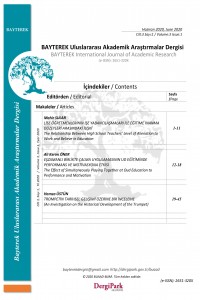Öz
Bu araştırmanın amacı, eşzamanlı birlikte çalma uygulamasının ud eğitimi alan öğrenciler üzerinde etkisini ortaya koymaktır. Araştırmanın çalışma grubunu Aksaray Üniversitesi Eğitim Fakültesi Müzik Eğitimi Anabilim Dalı’nda eğitim gören 10 öğrenci oluşturmaktadır. Araştırmacı tarafından geliştirilen ud etüdleri ve bir eser, “eşzamanlı birlikte çalma uygulaması” yapılarak öğrencilere bir ders dönemi boyunca uygulanmıştır. Araştırmada nitel araştırma modeli olan eylem araştırma deseni kullanılmıştır. Araştırma sonunda eşzamanlı birlikte çalma uygulamasının öğrencilere performans ve motivasyon açısından önemli katkısı olduğu gözlemlenmiştir. Ayrıca öğrenciler gerçekleştirilen uygulama sonrası bu uygulamanın kendilerine motivasyon sağladığına yönelik görüş bildirmişlerdir.
Anahtar Kelimeler
Kaynakça
- Demir, Erdem (2002); “Kişilik Özelliklerinin Girişimciliğe Etkisi”, Yayınlanmamış Yüksek LisansTezi, Gebze YTE Sosyal Bilimler Enstitüsü, Gebze.
- Dilts, Robert, (1998). Motivation, http://www.nlpu.com/Articles/artic17.htm
- Erten, C.F. & Çilden, Ş. YYÜ Eğitim Fakültesi Dergisi, 2018; 15(1):248-267
- Kaçar,G.Ü. Gazi Eğitim Fakültesi Dergisi Cilt 23, Sayı 1 (2003) 69-77
- Köklü, N. (1993). Eylem araştırması. Ankara Üniversitesi Eğitim Bilimleri Dergisi, 26(2), 357-366
- O'Brien, R. (2003). An overview of the methodological approach of action resaerch. Retrieved from http://www.wb.ne Vrobrien/papers/ artinal.hUm, Erişim Tarihi: 10.01.2019.
- Öztuna, Y. (2006).Türk Mûsıkîsi Ansiklopedik Sözlüğü. Ankara: Orient Yayınları
- Torun, M. “Gelenekle Geleceğe” Ud Metodu, Çağlar Yayınları, İstanbul, 1996
- Yıldırım, A. & Şimşek, H. (2013). Sosyal bilimlerde nitel araştırma yöntemleri. (9. Baskı). Ankara:SeçkinYayıncılık
Öz
The purpose of this study is to investigate the effect of simultaneously playing together on students who are undergoing oud education. Study sample was constituted with ten undergraduate students who are students at Aksaray University Education Faculty Music Education Department. Oud exercises and one piece that was developed by researcher were carried out to students for one term by “simultaneously playing together”. Action research that is a design of qualitative research method was used. It was observed after research that simultaneously playing together practice had an important contribution to students in terms of performance and motivation. Furthermore students delivered positive opinions about these practices. With the simultaneous playing together application, it is aimed to develop new teaching techniques in oud education. In the light of this purpose, the form of action research was designed. Action research is a group of people identifying a problem, doing something to solve the problem, seeing how successful their efforts are, learning to try again, if they are not satisfied with the result, by doing, by doing and living. In this study, the difficulties encountered in the oud instrument were tried to be identified through simultaneous collaboration. The action research pattern has been selected because it is solution-oriented in applied research and provides intervention during the research, as it provides convenience to the researcher. It is observed that the application of the simultaneously playing together in all institutions where instrument training is provided is revealed by this research, which is important for the development of instrument education of students. It is thought that the accompanying of the instrument trainer with the students in the lessons has emerged in this research with the opinions of the researchers and students, which created great differences in the students in terms of motivation, trust, instrument handling, weighing, rhythm and pitch pressure. In addition, the researcher observed that there were great differences in students' motivation, confidence, instrument handling, weighing, rhythm and pitch pressure during and after this application.
Anahtar Kelimeler
Kaynakça
- Demir, Erdem (2002); “Kişilik Özelliklerinin Girişimciliğe Etkisi”, Yayınlanmamış Yüksek LisansTezi, Gebze YTE Sosyal Bilimler Enstitüsü, Gebze.
- Dilts, Robert, (1998). Motivation, http://www.nlpu.com/Articles/artic17.htm
- Erten, C.F. & Çilden, Ş. YYÜ Eğitim Fakültesi Dergisi, 2018; 15(1):248-267
- Kaçar,G.Ü. Gazi Eğitim Fakültesi Dergisi Cilt 23, Sayı 1 (2003) 69-77
- Köklü, N. (1993). Eylem araştırması. Ankara Üniversitesi Eğitim Bilimleri Dergisi, 26(2), 357-366
- O'Brien, R. (2003). An overview of the methodological approach of action resaerch. Retrieved from http://www.wb.ne Vrobrien/papers/ artinal.hUm, Erişim Tarihi: 10.01.2019.
- Öztuna, Y. (2006).Türk Mûsıkîsi Ansiklopedik Sözlüğü. Ankara: Orient Yayınları
- Torun, M. “Gelenekle Geleceğe” Ud Metodu, Çağlar Yayınları, İstanbul, 1996
- Yıldırım, A. & Şimşek, H. (2013). Sosyal bilimlerde nitel araştırma yöntemleri. (9. Baskı). Ankara:SeçkinYayıncılık
Ayrıntılar
| Birincil Dil | Türkçe |
|---|---|
| Konular | Eğitim Üzerine Çalışmalar |
| Bölüm | Makaleler |
| Yazarlar | |
| Yayımlanma Tarihi | 30 Haziran 2020 |
| Kabul Tarihi | 30 Haziran 2020 |
| Yayımlandığı Sayı | Yıl 2020 Cilt: 3 Sayı: 1 |

Bu eser Creative Commons Atıf-GayriTicari-AynıLisanslaPaylaş 4.0 Uluslararası Lisansı ile lisanslanmıştır.


